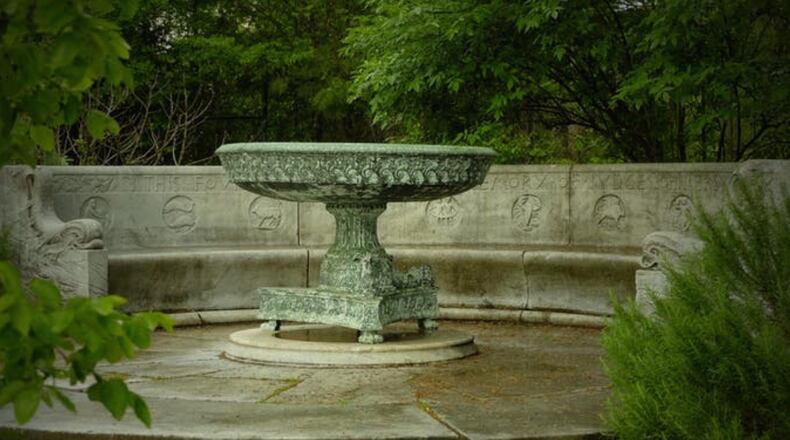A group of Grant Park neighbors is throwing a fundraiser tonight for an Atlanta landmark that has come to symbolize how the city has sometimes treated its historic relics — with apathy and neglect.
The Erskine Memorial Fountain was the city's first public fountain, originally dedicated in 1896 in a ceremony that drew about 1,500 people to hear a speech from the mayor about municipal responsibility. Today, it languishes in a state of ruin at the intersection of Cherokee Avenue and Ormond Street, on the outskirts of Zoo Atlanta.
The Friends of Erskine wants to raise $95,000 to restore the fountain and its marble platform and give the surrounding grounds a major spruce-up. Tonight's fundraiser starts at 6 p.m. at the Grant Mansion at 327 Saint Paul Ave. SE, and whatever is raised will be doubled through Grant Park Conservancy's Park Pride matching grant.
Here are five things you may not know about the Erskine Memorial Fountain, or what’s left of it.
1. It’s named after a Reconstruction-era federal judge who had a mixed record on racial issues.
Irish-born John Erskine was a teacher and an attorney who bounced around Florida and South Georgia before settling in Atlanta just in time for the Civil War. He opposed secession and then departed from the South after the conflict ended, moving to New York.
President Andrew Johnson, a fellow Southern anti-secessionist, thought Erskine would make an excellent federal judge, sending him back to Georgia.
According to a thoroughly researched article at HistoryAtlanta.com, Judge Erskine would repeatedly back the rights of white property owners. He opened the courts to black jurors, but he also made rulings that supported segregation and the ban on miscegenation.
After retiring, he had a plan to erect Atlanta’s first public fountain, but he died in 1895 before he could carry it out. So his daughter Ruby Ward used $15,000 of her own money (about $457,000 in today’s dollars), hiring renowned memorial designer J. Massey Rhind to fulfill her father’s dream.
2. People used to drink out of it.
The fountain’s first location wasn’t in Grant Park, but in Midtown at the intersection of Peachtree and West Peachtree streets, on what’s currently Hardy Ivy Park. (To make room for the Erskine Fountain, the city moved a statute of Confederate States Senator Benjamin Hill over to the state Capitol.)
While it looks something like a bird bath now, it used to have an ornate upper bowl that poured streams of water, and the lower bowl had bronze cups attached to chains so passersby could take drinks.
Nowadays, even pigeons might think twice about sipping from it.
3. Progressive Era hooligans used to write dirty words on the bench.
Despite what the mayor said in his dedication speech, the Erskine Fountain soon suffered from neglect and struggled with vandalism at its first location. The pipes weren’t properly maintained, so water spilled out onto the nearby sidewalk. And youngsters of the 1900s, kids who grew up in the era of the Wright brothers’ flight and the introduction of the Ford Model T, would write dirty words and slogans all over the marble bench. Gadzooks!
On the one hand, such vandalism must have looked disgraceful on the bench's the delicately carved 12 zodiac signs. On the other hand, the hooligans used pencil and chalk in those days, which is much easier to clean than spray paint.
4. It once overlooked a six-acre lake in Grant Park.
The city moved the fountain to its current home in 1912. It backs up to a chain-link fence now, but for decades that was considered the gates to Grant Park, overlooking a beautiful view of Lake Abana.
The lake was once a popular recreation spot, with two islands and room for canoeing. It also had a pool, tennis courts and a movie screen.
But to avoid being forced to integrate the lake during the civil rights era, the city chose to drain it and build a parking lot for the zoo, or so the story goes.
5. Efforts to save it date back a long, long time.
As bad as Atlantans treated the fountain in its first location, they were outraged when a city official told The Atlanta Constitution about plans to demolish and dispose of it. That prompted the first Erskine Fountain preservation effort, led by the legal community and other prominent residents. The city considered moving it to Piedmont Park, but settled on Grant Park.
The fountain had a brief heyday again, but then neglect and deterioration started all over. Vandals struck and stole fountain pieces. Other parts rusted. Weeds grew in the cracks of the marble pedestal. The water hasn’t flowed in a very long time.
Grant Park neighbors, seeing something special in the historic piece of public art, organized to restore it in 2015, holding several fundraisers and cleanup days.
The fountain falls under the purview of the Grant Park Conservancy, which has a memorandum of understanding with the city to rejuvenate the park. This year the conservancy won a $100,000 Park Pride Legacy grant to help restore the Erskine Memorial Fountain, the Lion Bridge and the Milledge Fountain.
The Friends of Erskine fundraiser tonight is called "Let the Fountain Flow." Click here for tickets.
About the Author
The Latest
Featured











